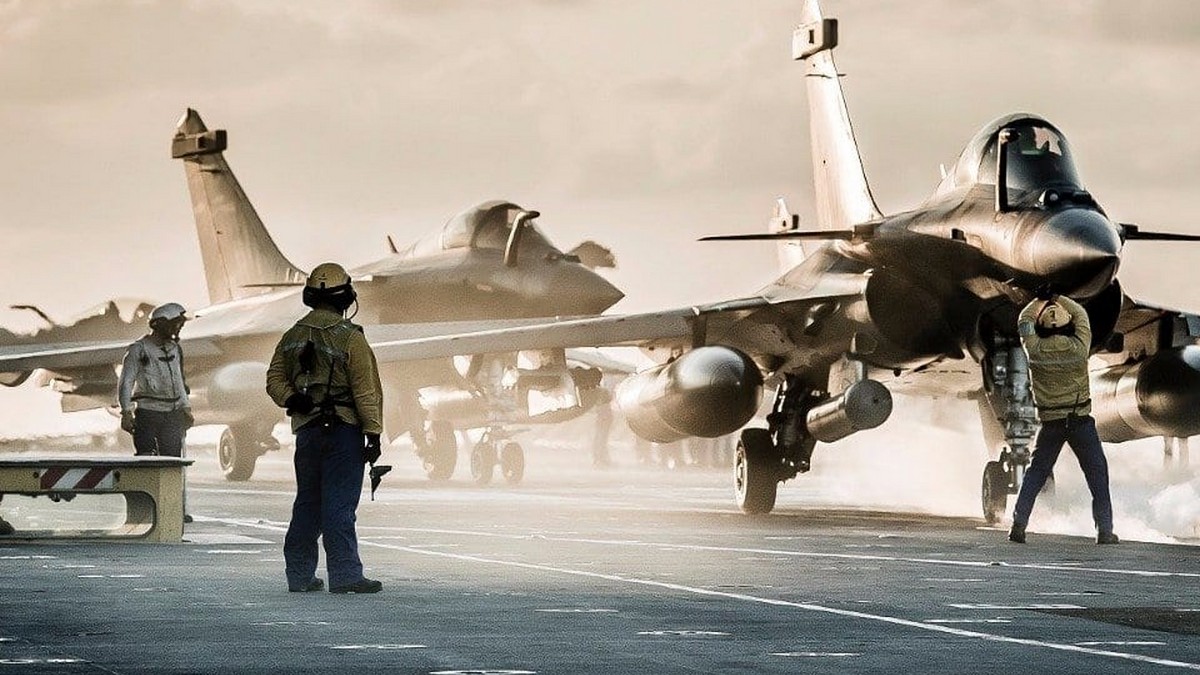India is set to begin negotiating the purchase of 26 Rafale Marine fighter jets from France.
The Indian government will begin negotiating the Rs 50,000-crore deal with a high-level French team in New Delhi.
The French side will with Indian defence ministry counterparts to begin official negotiations in the jet deal for the Indian Navy under which aircraft would be operated from both aircraft carriers operated by the force, defence industry officials told ANI.
The French team will include officials from their defence ministry and industry including original equipment manufacturers Dassault Aviation and Thales, the officials said.
The Indian side would include members from the defence acquisition wing and the Indian Navy.
But what do we know about these naval fighter planes?
Let’s take a closer look:
‘Omnirole aircraft’
The Rafale M is a single-seat, twin-jet fighter plane that operates from aircraft carriers.
It can carry out several missions including air defence, air policing, nuclear deterrence, power projection and deployments for external missions, deep strike missions, air support for ground forces, reconnaissance missions, and pilot training sorties.
The jet has a wingspan of 10.90 metres, is 15.30 metres long and 5.30 metres high.
It has a maximum take-off weight of 24.5 tonnes and can carry an external load of up to 9.5 tonnes.
Impact Shorts
More ShortsIts maximum speed is 1.8 Mach (1,389 kmph).
It can operate at a maximum altitude of 50,000 feet.
The Dassault website describes the Rafale as an “omnirole” aircraft.
“Its design makes its relevant against both traditional and asymmetrical threats, it addresses the emerging needs of the armed forces in a changing geopolitical and security context, and, with its endless growth potential, it constantly remains at the forefront of the technical innovation,” the website states.
According to Economic Times, the craft can conduct air-to-ground and air-to-air missions simultaneously.
It mission system supports weapons such as the long-range Meteor missile, MICA missiles, HAMMER, SCALP, AM39 EXOCET, and laser-guided bombs, along with a 2,500 rounds-per-minute NEXTER internal cannon.
According to PTI, the fighter aircraft has Active Electronically Scanned Array (AESA) radar with increased situational awareness due to early detection and tracking of multiple targets.
According to The Times of India, the Rafale-M’s Thales RBE2-M is designed for maritime operations.
Its electronic warfare suite is called the Thales SPECTRA.
It also has a reinforced undercarriage.
It also has a “jump strut” nosewheel that expands during short takeoffs like catapult launches.
Equipped with a microwave landing system, the naval version of Rafale has a “fin-tip Telemir system for syncing the inertial navigation system."
Rafale Marine preferred over Super Hornet
According to the Economic Times, India decided to go in for the Rafale Marine rather than the American F/A-18 Super Hornet.
This came after rigorous testing at the shore-based test facility in Goa.
A big advantage of the Rafale M is that it is compatible with India’s existing Rafale planes.
This is likely to bring down costs when it comes to spare parts and maintenance.
The crafts are thought to have 80 per cent of their components in common.
The main difference between the planes is in the “longer, more strengthened nose,” and landing, as per the newspaper.
The Rafale-M has a nosegear-mounted catapult hook which will “enable the aircraft to be aligned and correctly tensioned, ready for catapulting, increasing launch speed and eliminating the need for deck crew to work under the aircraft,” according to the website FlightGlobal.
The fighter jet has a tailhook or arresting hook to stop the plane during landings.
Sources in the government said they would try to complete negotiations with France and sign the agreement by the end of this financial year.
According to Financial Express, the Indian side is looking to sign the contract this fiscal year.
France is expected to start delivering the planes in 2027.
Sources said that while the Indian Navy was preparing to send bid papers to France, a joint bid with the IAF is not thought to be on the cards.
In France, the navy and air force both operate the Rafale fighters.
They thus share common stores.
No joint bid
Sources said a joint bid with the Indian Navy could have possibly lowered the cost of the planes and perhaps even led to a new production line being established in India.
“Setting up a production line for building an aircraft in India is all dependent on the numbers. It is not financially viable to set up a new production line for a small number of fighter jets,” the source told the newspaper.
The IAF has formed two Rafale squadrons — Hasimara and Ambala — each having its own stores and simulators.
In December, France had submitted its response to India’s tender for 26 Rafale Marine jets for the Navy’s aircraft carriers INS Vikrant and INS Vikramaditya. The response to India’s Letter of Acceptance was submitted in New Delhi.
The Indian side has carried out a detailed study of the French bid for the Indian deal including the commercial offer or price for the aircraft, along with other details of the contract, they said.
India will now go in for tough negotiations with French government officials, as it is a government-to-government contract.
The Navy Chief has directed his team to ensure the timeframe required for the project was squeezed significantly to ensure early finalisation and induction of the planes in the inventory.
With inputs from agencies


)

)
)
)
)
)
)
)
)



